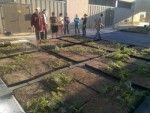Students increasingly hear more and more about going green and research endeavors to make humans more environmentally friendly. Texas A&M is an incubator for one such research endeavor that involves what are known as green roofs.
The concept of green roofs first originated in Europe with extensive adoption by countries such as Germany, Austria and Switzerland. The prime objective behind the implementation of green roofs is to reduce the effect of direct sunlight on buildings, which in turn results in energy conservation. A green roof system relies on three parts: a high quality waterproofing system, a lightweight growing medium and robust plants.
The green roof research project at Texas A&M University was born out of the need to address the lack of such initiatives in Texas and other nearby states.
“Green roofs have been implemented in some cities in the northern region of the United States, said Bruce Dvorak, assistant professor of landscape architecture and urban planning development. But not much research has been done to identify the characteristics of a green roof that will thrive in the weather conditions unique to Texas and its adjoining states.”
Dvorak initiated the research in 2009, focusing on plant sustainability without water and its effects on the temperature of the surface and water flow. This research naturally progressed into a project entailing the construction green roofs.
Along with Astrid Volder, associate professor of horticultural sciences, and Don Conlee, associate professor of meteorology, Dvorak received a grant of $30,000 from the University in 2012 to be dispensed over three years. The grant was intended to kick-start a research project aimed at understanding and building green roofs.
In conjunction with Dvorak, Volder overlooked the aspect of the project, which dealt with selection of plants best fit for green roofs and subsequently studied them over the research period.
Conlee supervised the installation of various sensors and weather apparatuses to keep track of the changes in the environment. The data from all the sensors is stored in an onsite data logger, to be used later in correlation to the maturity of the green roof.
Another highlight of this research project is the keen involvement of the students. Although this project is led by three professors, it is implemented and managed by students. Students from various departments helped assemble the green roof, accumulate the data and analyze it with the help of their mentors to infer results.
The process of building the green roof was accomplished in stages.
“We started in September by placing a waterproof membrane and then putting roof tiles on it, Dvorak said. This was to prevent seepage and avoid structural damage. Then we strategically placed the planting modules which consist of media such as soil and gravel necessary for plant growth.”
Kirk Laminack, horticulture graduate student, is the primary student supervisor for this project.
Laminack said the plants chosen to be included in the experiment were first planted in the horticulture department and then transferred to the location. Many different combinations of plants were placed in modules to understand the dependency between the different types of plants.
“We helped propagate plants in the beginning, that is cut and replant parts of existing plants to grow new ones using a growth hormone that tells the severed pieces to grow roots, said Nancy Luong, senior environmental studies major. We started setting up our modules in the horticulture greenhouses near the [Student Computing Center] in October, and by the first week of November all of the modules were installed on top of Langford [building].”
Dvorak said the final stage was setting up the irrigation system and the sensors. He said a very sparse irrigation system is being implemented to ensure the plants are drought tolerant and can survive in harsh conditions.
Luong and other students were responsible for collecting samples daily at even hour intervals and later representing the data in a graphical format.
“I gained hands-on experience installing Texas A&M’s first true green roof and got a preview at what it was like to be involved in and present research to a group of judges, Luong said. It was my first class where I got my hands dirty, nails caked in soil and planted as part of a campus wide project. It was a rewarding experience, especially looking back at the state of the roof before we started and how far we progressed.”
Rooftop recharge
January 23, 2013

Donate to The Battalion
Your donation will support the student journalists of Texas A&M University - College Station. Your contribution will allow us to purchase equipment and cover our annual website hosting costs.



















